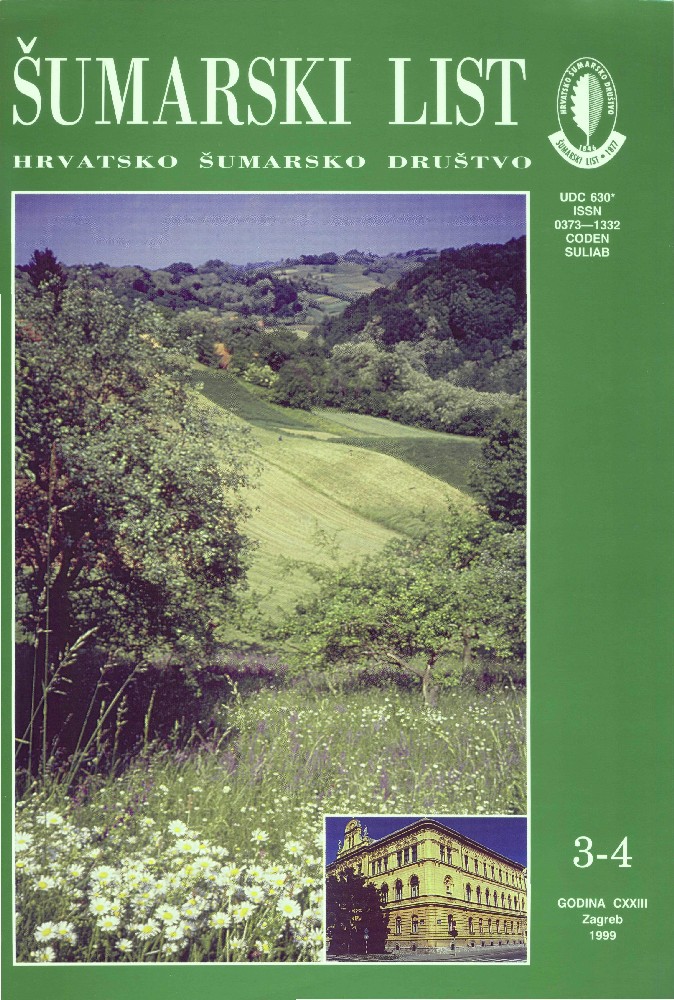
broj: 3-4/1999
pdf (20,2 MB) |
|
||||||||||||||
| IZVORNI ZNANSTVENI ČLANCI | ||
| Pleše, N., Juretić, N. | UDK 630* 444 (001) | |
| Virus Disease of Field Elm (Ulmus minor Mill.) in Croatia pdf HR EN | 95 | |
| Pernar, N., Bakšić, D., Španjol, Ž. | UDK 630* 114.2 + 235 (001) | |
| Some Characteristics of Humization in Pine Plantations on the Island of Rab pdf HR EN | 101 | |
| Kovačević, M. | UDK 630* 231 + 434 (001) | |
| Natural Regeneration of Wood and Macchia on the Burned Surfaces in Arboretum Trsteno pdf HR EN | 109 | |
| PRETHODNO PRIOPĆENJE | ||
| Grubešić, M., Dorotić, I. | UDK 630* 156 + 41.423 : 116 | |
| The Impact of Flood on Game and Hunting pdf HR EN | 119 | |
| PREGLEDNI ČLANCI | ||
| Harapin, M. | UDK 630* 453 | |
| The horse-chestnut miner (cameraria ohridella Deschka & Dimić) a dangerous pest in Europe pdf HR EN | 129 | |
| STRUČNI ČLANCI | ||
| Knepr, J. | UDK 630* 241 + 362 | |
| Simultaneous Research on the Performance of Motor Trimmers and Chain Saws pdf HR EN | 133 | |
| Summary: Mechanical and manual work in silviculture has been a frequent discussion and research topic aimed at selecting the most appropriate machine for practical use. This paper presents the results of simultaneous monitoring of motor trimmers and a chain saw in felling trees and a twenty-three-year old stand. The operations were carried out on eight parallel plots in a stand of beech and pedunculate oak with common hornbeam mixed with allochtonous conifers.The cutting tool connected to the trimmers was a circular saw with 48 triangle-shaped teeth. The desired objective was to establish a possibility of using the trimmers in stand tending; another aim was to find the differences in the efficiency between the various trimmers and the light-duty chain saw, the latter otherwise used in silviculture. The tested trimmers were STIHL FS 360, SHINDAIWA RC 45 and ECHO CLS 4600. The chain saw was STIHL 024. Each of the machines was used in two plots with altogether 1200 trees, their diameters ranging from 30 to 250 mm at stump level. The results are presented on Table 5. The differences in effective use of time and fuel are established for the same size, i.e. cutting surface of 10 m2. In columns 5, 6, and 7 of Table 5 a small difference in effective time use is established. The effective time spent with FS 360 was 2770.7 minutes; with RC 45, 2962.4 ; CLS 4600, 2871.9; chain saw STIHL 024 S, 1775.0 minutes. Accordingly, 36 to 40% of effective time is saved by using the chain saw, when compared to the use of motor trimmers. The same table presents fuel consumption of the trimmers in column 17, 18 and 19, and of the chain saw in column 20. The differences among the trimmers as to their fuel use are negligent: 8.32 l/F 360: UP TO 8.87 l/CLS 4600. Compared to motor trimmers, the fuel consumption of the chain saw is by 23% lower (6.24 l). The conclusion contains other characteristics, advantages and disadvantages of the monitored machines. | ||


